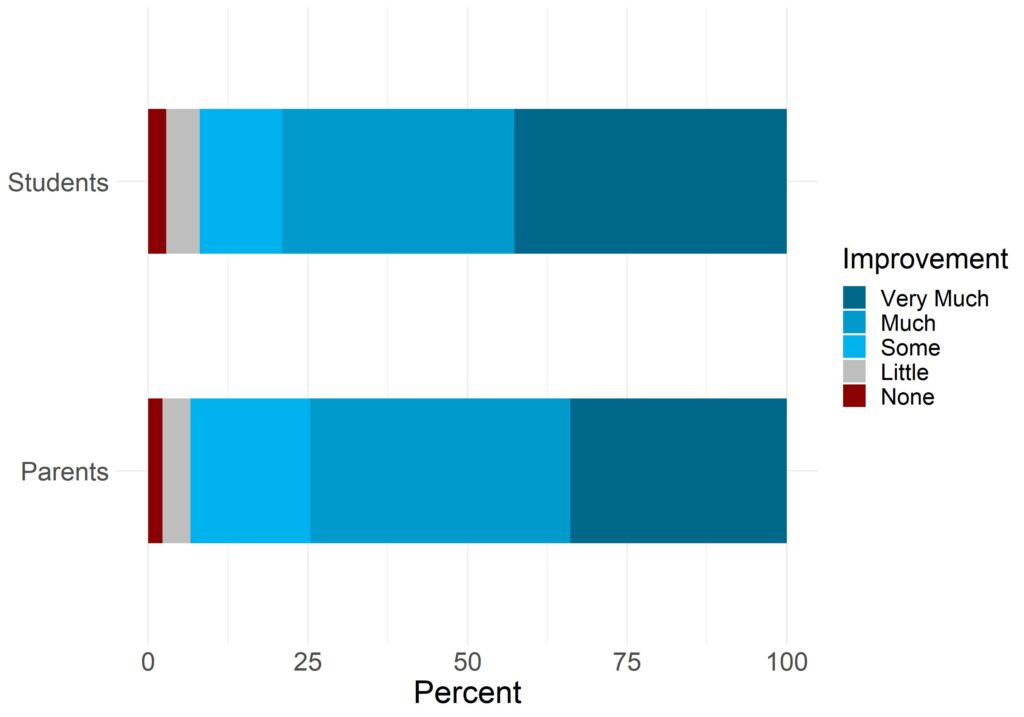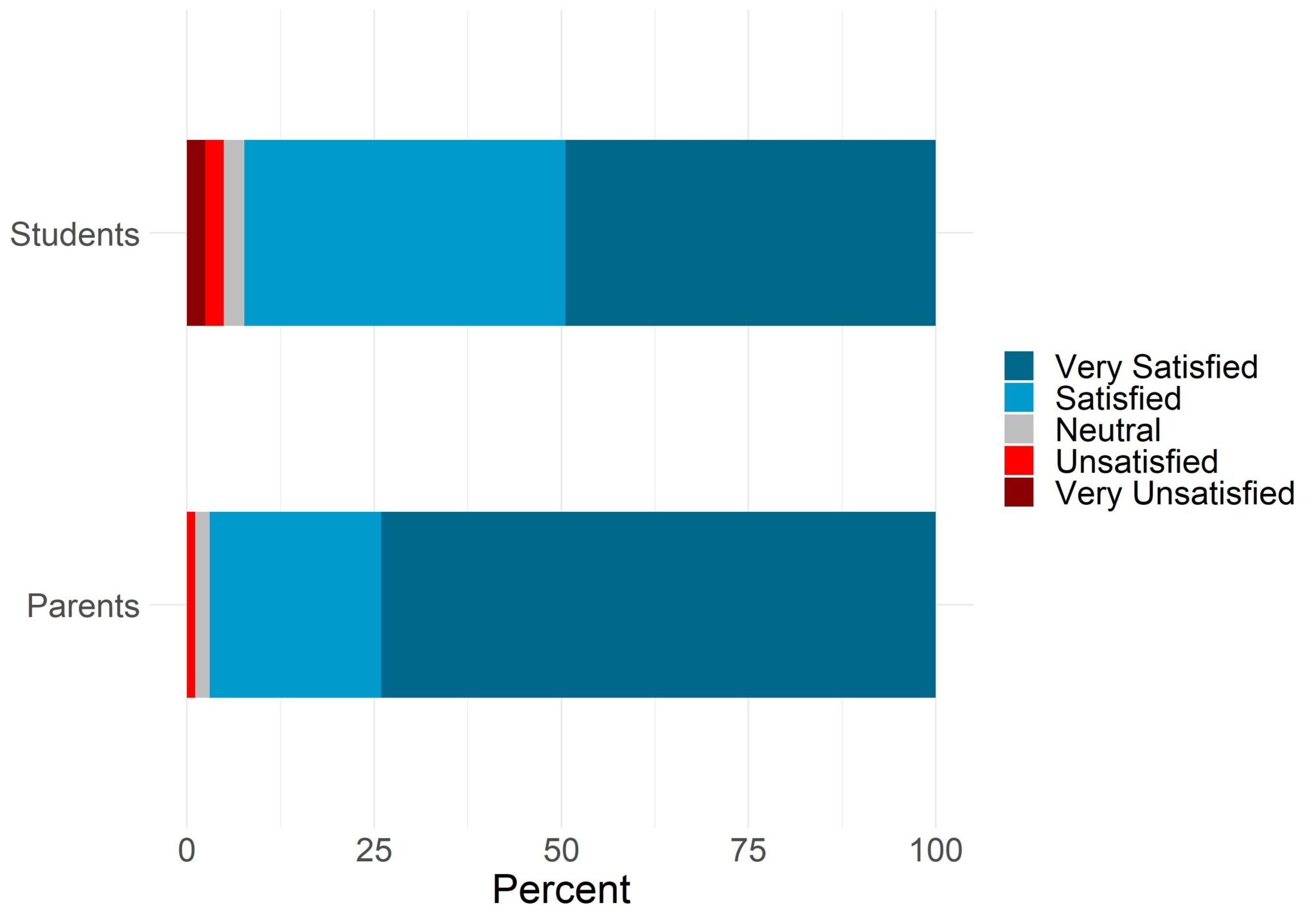Elements Research Findings
We take pride in utilizing evidence-based treatments for a simple reason: they work. Similarly, to best serve our clients and their families, we recognize the importance of data collection, research, and program evaluation. We are committed to gathering outcome data on our clients’ experiences at Elements and beyond. On-going data collection helps us understand what’s working for our clients and how to continue improving.
Each new participant of our program is asked to fill out three questionnaires upon intake, at discharge and then six months and one year after discharge. The following graphics are based on data from these questionnaires.
What are participants saying about Elements?
How Satisfied were you with the quality of treatment you or your child has received?
Quality of Treatment:
Sample size: Parents = 362, Students = 287
0-1: Very Unsatisfied, 2-4: Unsatisfied, 5: Neutral, 6-8: Satisfied, 9-10: Very Satisfied
97% of Parents and 92% of Students reported being Satisfied or Very Satisfied with their treatment when asked at discharge.
How would you currently describe your or your child’s problems compared to when you/he entered the program?
Improvement in Problems:
 Sample size: Parents = 363, Students = 286
Sample size: Parents = 363, Students = 286
0-1: No Improvement, 2-3 Little Improvement, 4-6: Some Improvement, 7-8 Much Improvement, 9-10: Very Much Improvement
93% of parents and 92% of students reported experiencing between some improvement and very much improvement when asked to rate their or their child’s problems compared to when they entered the program.
Who We Serve
At Elements Wilderness Program, we strive to provide custom treatment plans tailored to your son’s specific needs. Our admissions team will help fit your son with the group that he will be mostly likely to succeed in. Most of the clients we work with arrive with several co-occurring diagnoses and often the most evident of these is a compulsive disorder such as technology overuse or substance abuse. These compulsions are almost always just the tip of the iceberg as shown on the following graphics based on Element’s data. Our program focuses on addressing these underlying the root issues an individual is struggling with instead of just the surface level behavioral issues.
Compulsive Behaviors are just the Tip of the Iceberg
Elements focuses on addressing the underlying root emotional causes of maladaptive behavior
What does the Data say?
Many researchers have documented that exposure to nature can have positive effects on mental health.* The growing field of Outdoor Behavioral Healthcare attempts to unite the intrinsically healing power of nature with clinically tested therapeutic techniques. Elements wilderness therapy program (EWP) is based around 6 Core Therapeutic Methods:
- Assessment
- Understanding the individual’s needs and targeting with specific interventions.
- Individual and group therapy
- Therapy tailored to the individual and individuals improve their interpersonal functioning.
- Family therapy and engagement
- Improving family relationships by working on communication and understanding in the family system.
- Dialectical Behavioral Therapy (DBT)
- Teaches skills based in mindfulness, distress tolerance, emotion regulation, and interpersonal effectiveness.
- 7 Challenges
- A framework for approaching compulsive behaviors such as technology overuse and substance abuse. Click here for more information.
- Outdoor and Adventure Therapy
- Adventure Programing, wilderness living skills
EWP has always pursued the goal of providing cutting edge mental health treatment in a wilderness setting. This treatment equates to improved functioning for our graduates in all areas of life including school performance, family cohesion and peer to peer interaction. In order to provide the best care possible to your son, we utilize a standardized clinical outcome instrument called the Youth Outcomes Questionnaire (YOQ). Click here for more information on the YOQ. The YOQ is used to measure treatment progress in youth populations receiving a mental health intervention.*
Mental Health Functioning
How does participation at EWP impact participants’ mental health functioning?
Note: Higher scores indicate higher levels of mental health dysfunction . Scores above the dotted line (“clinical cutoff”) indicate the need for a mental health intervention while scores below the dotted line show the normative range as according to the Youth Outcomes Questionnaire.
The above figure includes data from participants at Elements Wilderness Program from both parents (reporting on their child) and students (self report) who attended the program between 2017 and 2021.** As you can see, both parents and students reported the student arriving well above the clinical cutoff and discharging below the cutoff in the normative range. Further, these improvements were maintained six months and one year after discharge.
Family Functioning
How does participation in EWP impact perceptions of family dynamics?
 Note: Higher scores indicate poor perceptions of family dynamics. Scores above the dotted line (“clinical cutoff”) indicate the need for a family relationship intervention while scores below the dotted line show the normative range as according to the Family Assessment Device.
Note: Higher scores indicate poor perceptions of family dynamics. Scores above the dotted line (“clinical cutoff”) indicate the need for a family relationship intervention while scores below the dotted line show the normative range as according to the Family Assessment Device.
As shown above, both parents and students rate the family as being in need of family therapy when surveyed at admission. Although this score shows improvement at discharge, it still falls above the cutoff because students and parents have not had the chance to put the skills they learned at Elements into practice yet. At one year post discharge, both groups report being in the normative range of family functioning. It is also interesting to note that students report more significant successful gains in their perceptions of family dynamics. This could be because during Elements, parents have engaged in family therapy where they learn skills to help attune, understand and communicate with their child.
*Citations
Bratman, G., Hamilton, J., & Daily, G. (2012) The impacts of nature experience on human cognitive function and mental health. annals of the New York Academy of Sciences, 1249, 118-136. http://willsull.net/resources/BratmanHamiltonDaily2012.pdf
Burlingame, G., Cox, J., Wells, G., Latkowski, M., Justice, D., Carter, C., & Lambert, M. (2005). The administration and scoring manual of the Youth Outcome Questionnaire. Salt Lake City, Utah: OQ Measures
Gillis, H. L., Speelman, E., Linville, N., Bailey, E., Kalle, A., Oglesbee, N., Sandlin, J., Thompson, L., & Jensen, J. (2016). Meta-analysis of treatment outcomes measured by the y-oq and y-oq-sr comparing wilderness and non-wilderness treatment programs. Child & Youth Care Forum, 45(6), 851–863. https://doi.org/10.1007/s10566-016-9360-3
Tillmann S., Tobin D., Avison W., & Gilliland, J. (2018) Mental health benefits of interactions with nature in children and teenagers: a systematic review. Journal of Epidemiology & Community Health 72(10), 958-966.
**Note: all data presented contains some percentage of predicted values based on a linear model. No difference was found statistically between these predicted values and the original data.



